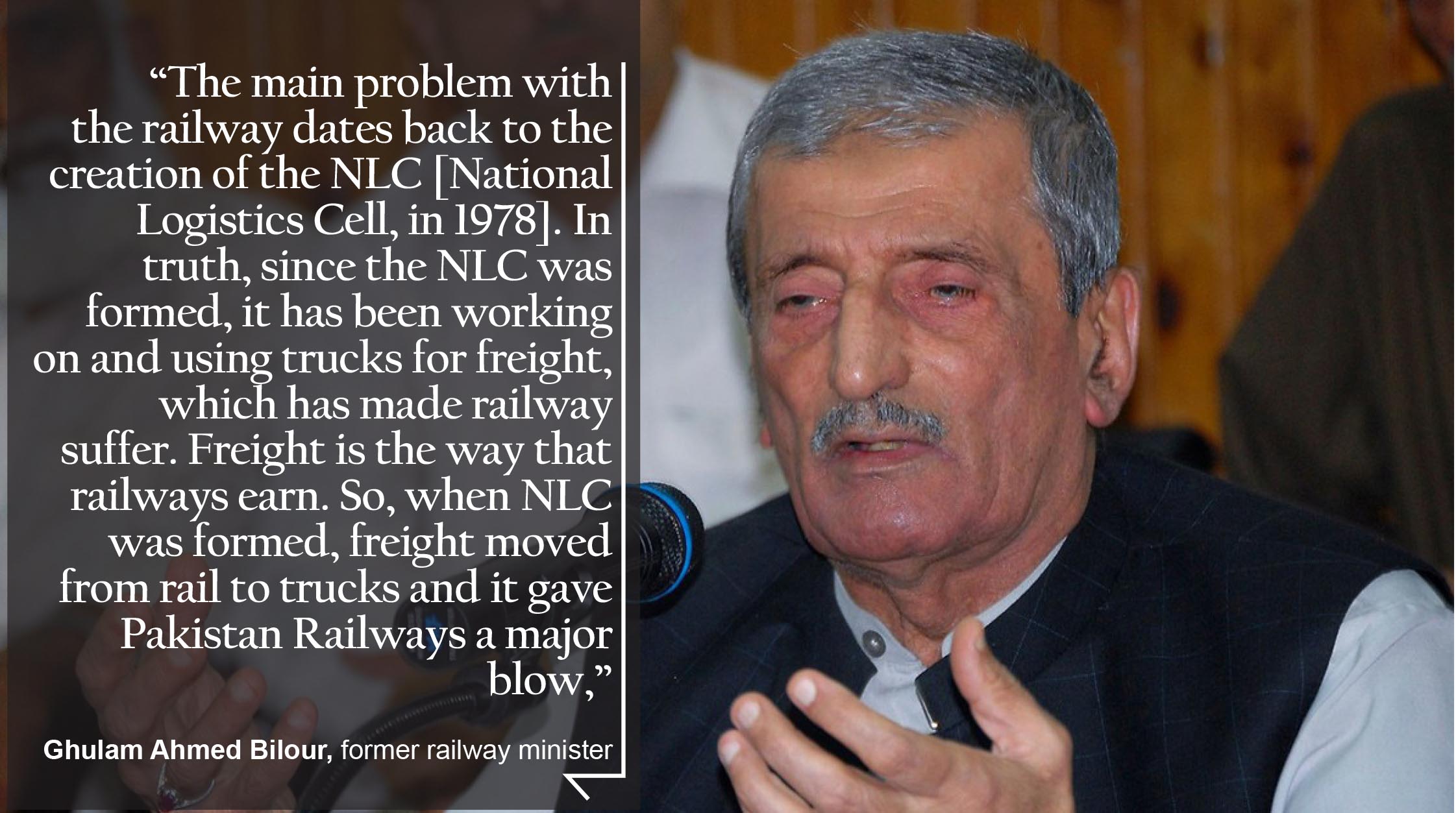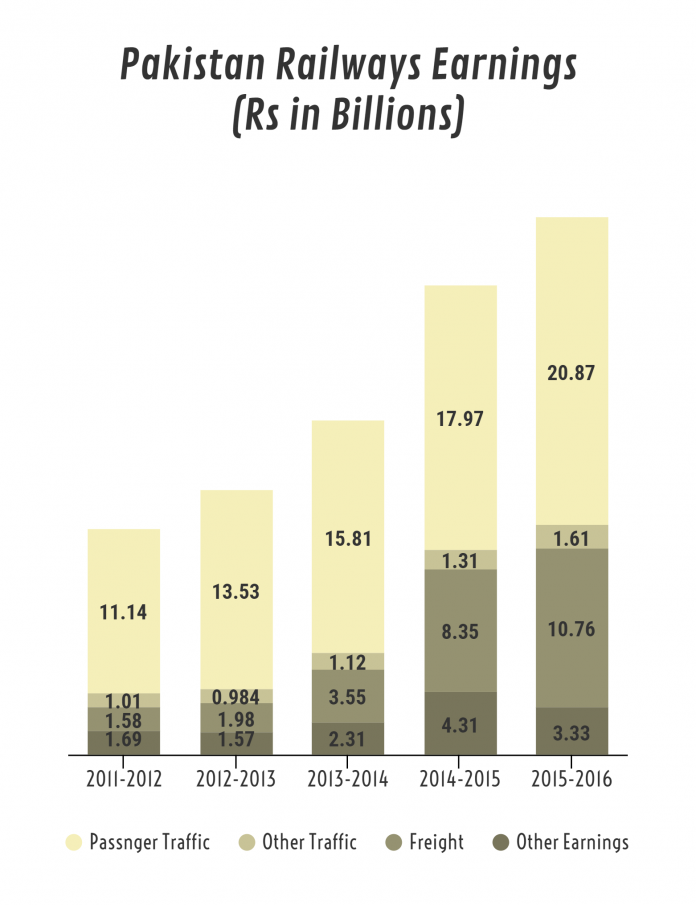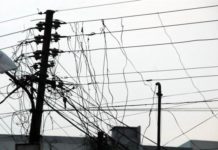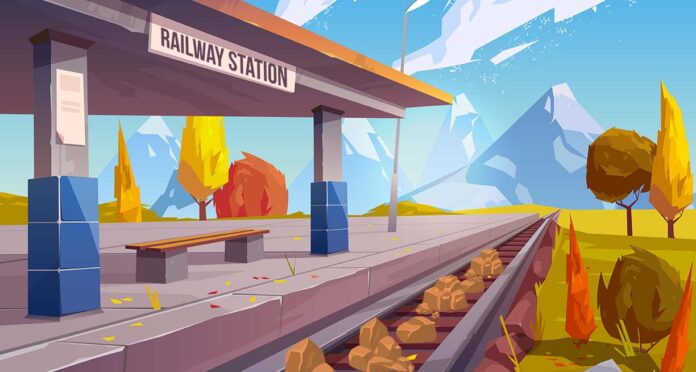In 2017, Profit carried a feature detailing the history, trials, tribulations, and possible revival of the Pakistan Railways. Back then, the railways were going through a rejuvenation under the stewardship of Khawaja Saad Rafique, who was the minister for railways in the Nawaz Sharif cabinet.
It was a good time to look back and reflect at the history of the railways in Pakistan. After a disastrous run under the Pakistan People’s Party (PPP) government from 2008 to 2013, during which time the railways were run by the ANP’s Ghulam Ahmed Bilour in the Gilani led coalition government of the time, it seemed that the fortunes of the national company had turned.
Saad Rafique had come in with fresh resolve and taken an organisation sinking in the quicksand of persistent deficits by the horns and within a few years had gotten it to a position where it was turning profits. Now, with the PML-N administration gone, Saad Rafique a distant memory, and the incumbent PTI government already on its second minister for railways, we are standing in much the same position as we were back in 2013.
While the Pakistan Railways is in not nearly as much trouble as it was back then, it is still facing increasing challenges and competition. The last time we covered this subject in 2017, Profit detailed the history of the railways from its colonial inceptions to its role in developing the Pakistani economy through the 50, 60s, and 70s and traced this history all the way back to the state that the railways found itself in in 2013, when Saad Rafique took over from Ghulam Ahmed Bilour.
The scope of this article is not as grand, and instead it will focus on the current woes it finds itself in. Because in the past four years, under Sheikh Rashid Ahmed and Azam Swati, the railway has lost the luster it had regained and is on the brink of de facto privatization, even if that is not what the government is calling it. The main topic of contention at this hour is the proposed restructuring of the railways, which will leave it completely controlled by private corporations.

To understand how things got here, we will look closely at some of the events and challenges leading up to where we are now, including the role of the National Logistics Cell (NLC), a mounting pension bill that keeps inflating the deficit, and how the incumbent government is proposing to restructure the organization so that it does not squander the gains made under the PML-N government. Most importantly, however, we will use the testimonies of both high ranking railway officials and grassroot employees of the organization to understand the problems the Pakistan Railways currently faces, and whether the solutions being proposed by the government will make things better or worse.
We will begin, of course, with why the railway matters so much to the imagination of the Pakistani economy, and then move on to issues.
Why the railways matter
This is something that needs to be reiterated. When most people in Pakistan think of railways, they think of long journeys being made even longer by delayed trains, extended maintenance stops, and made even more difficult because of uncomfortable conditions. Most people refer to the problems with the railway not because they see it as critical to the economy, but because they see its inefficiencies as an example of why our governance has never worked. The reality is that the railway is not just a symbol, it is a real ticking time-bomb for our economy. Passenger trains are the least of the concern of the railways, because the true profit lies in the carrying of cargo and freight.
And that is the second thing that most people do not realise – the railway is supposed to be a profitable organization. The relationship most citizens have with the railways is that it is a mode of transport, and a publicly owned mode of transport at that. When they think of the railways being late, or bad, or uncomfortable they simply put it down to that being part of Pakistan’s poor public transport infrastructure. Which is why when people hear of the railway being in loss or facing a deficit, they do not bat an eye – mostly because they think since public transport is subsidised it is not supposed to be turning a profit.
The problem with this perception is complacency. Every year when they go into a deficit, the government gives them money to bring them out of their troubles and they keep chugging along as they were before, not changing the things holding them back. The working culture at the Pakistan Railways has for the past few decades been lazy, bureaucratic, stubborn, and extremely resistant to change. Low wages, poor unionization, little to no accountability, and successive governments wanting to keep this eyesore of an organization out of sight and out of mind has allowed it to become lethargic and inefficient.
In reality, the modern Pakistani economy would not exist without the railway. Many of the problems that exist are the same. In the 2017 article in Profit, it was pointed out that trains arriving on time are considered a shock and almost nobody even blinks at the billions of rupees in bailouts (in addition to regular subsidies) that are paid out to the railway every year. Today, much is the same. It seemed for a while that CPEC and rising economic opportunities would turn the tide, we are much in the same place. But what are the problems that are facing the railway? The first is the NLC, which has been blamed by governments of the past as well, and the second is the creeping deficit and ballooning pension bill that the railway has to deal with.
The state of the crisis
By the time the PPP took over in 2008 from General Musharraf, there was still an impression that the national company was worth something and just needed a little dusting up to be brought back to its past glory. These illusions were very quickly shattered. If we look at the numbers, the deficit of the railways had increased from RS 12.6 billion to RS 18.6 billion in in 2008-09, then, in the following year, 2009-10, the deficit reached RS 20.1 billion and in the following year it reached RS 26.9 billion and in 2012-13 it reached RS 30.5 billion. In five years, the PPP government had more than doubled the deficit.

A lot has been said in this regard, and there is singular blame often ascribed to Ghulam Ahmed Bilour for this. It is true, his terms saw mammoth decline and under him the railway became a national crisis. Trains were grounded for all intents and purposes, railway employees were unhappy with the minister, and the general sentiment was that the only reason he was not being removed from office or replaced was because he belonged to the ANP, which was a crucial partner for Gillani administration to keep a hold on its coalition in the national assembly.
However, the neglect that the railway faced was much longer and had been going on for decades. As the 2017 article went to lengths to explain, there was an accounting trick the government implemented decades ago to make the financial statements of Pakistan Railways look healthier than they really were, and that since 1991, the position of head of the railways has been held, not by a member of the Railway Group of the Civil Service of Pakistan, but by a member of the powerful District Management Group (now known as the Pakistan Administrative Services).
But when Ghuam Ahmed Bilour had been asked in 2017 why he felt the railway had been in the dumps during his stint as minister, he did not point to either of these glaring facts which had been muddying the waters for decades and imploded when Bilour took over. Instead, he blamed the National Logistics Cell (NLC), saying the NLC had broken away from competition from the railway for freight.
“The main problem with the railway dates back to the creation of the NLC [National Logistics Cell, in 1978]. In truth, since the NLC was formed, it has been working on and using trucks for freight, which has made railways suffer. Freight is the way that railways earn. So, when NLC was formed, freight moved from rail to trucks and it gave Pakistan Railways a major blow,” he said in an interview four years ago.
The NLC
What is the NLC? In the late 1970s, a crisis was emerging at the Karachi port. Back then, the railways carried everything from wheat to consumer goods all across the country, and as far as Afghanistan. It was an impressive network, which had not been updated since we inherited it from the British colonisers. The problem was that the British had designed the railway to transport military equipment, personnel, and rations. That is why during the Raj, the British were very picky about what locals got jobs in the railway because they were afraid of secrets being leaked. So by the late 1970s, with increased economic activities, it was becoming apparent that the railway could no longer sustain the traffic and load being put on it.
This came to a head when the port handling system at Karachi came to a standstill. The situation was bad enough that emergency military help was called for and military trucks opened the way for the delivery of goods and helped restore normal port activities. This temporary crisis proved to be an opportunity. Up until this point, the railway had never had to face any competition. Now, suddenly, there were massive trucks that could carry freight across the country. This was a big thing because, remember, back then the country was not connected by a system of highways as it is now. And while the trucks were more expensive than the railway, they were far quicker and much more efficient.
The idea was floated to turn this temporary solution into a modern, integrated, institution and the NLC was established with the objective of creating a land transport infrastructure with the help of which during any natural and human emergency and as required military assets can be transferred quickly anywhere. Later, commercial transport activities were started to make NLC self-sufficient and within two years of its inception, NLC became self-sufficient – meaning it was already turning profits.

The NLC grew very quickly, and as a semi-military organisation, has found itself growing significantly. It formed its own engineering firm for infrastructural development, created its own polymer company in 1982, and by 1993 the NLC had introduced dry ports that provide business owners with the opportunity to access and penetrate hinterland markets. Since then it has founded its own tolling system, founded a technical training institute, created a driving school to train its fleet, and put its hand in marine and air services. The most crushing blow was in 2009, when they ventured into the railway cargo business and experimented with running the NLC Express Freight Train. In 2014, NLC purchased ten state-of-the-art Korean locomotives and leased them to the railways for ten years. The NLC has grown exponentially with each passing day.
Clearly the NLC has proven to be great competition for the railway, especially since it has developed constantly while the railway has fallen into disarray. But the NLC being an alternative to the railway is an insufficient explanation. After all, an NLC truck is still more expensive than a rail carriage. The only reason it would make sense for businesses to move their cargo shipping needs to the trucks would be if the railway was not available, or not reliable, or both. On that front, it appears that chronic underinvestment in infrastructure stretched not just to building new infrastructure, but maintaining old parts of it as well.
Cargo versus passengers
Another reason was that the railway, to appease the public, started acting as an organization that focused more on passenger transport than cargo. This is why the NLC which was growing rapidly, while on the other hand the conditions of the railways were rapidly driving it towards deficit as its focus was on passengers instead of cargo.
There have been a few incidents in the 2000s that have led the railways to a sharp financial deficit, for example, the railways purchased 69 locomotives from China’s Dongfeng Electric Company in 2003 because they were available at 37 percent lower prices than European and American-made locomotives. Soon these cheap locomotive platforms began to have manufacturing defects however, the company also repaired some locomotives but eventually, 32 of these locomotives had to be scrapped. The deal was struck during the Musharraf regime from 2000 to 2002 under Railway Minister Javed Ashraf Qazi. Sheikh Rashid, who took the office of the Railways Minister in 2006, blamed the use of bad and fake oil for the failure of Chinese locomotives. Very quickly the railway became a carcass and the vultures began to descend.
In 2010-11, a scrap scandal worth RS 3 billion was caught in the railways in which the names of the then Railway Minister, Secretary Railways, General Manager Railways and Chief Controller Stores and other officials came to light and the case was investigated by the FIA and NAB. In this scandal, 39,000 metric tons of machinery was handed over to private contractors in the name of scrap. At that time the market rate of scrap was RS 37,000 per MT but four contractors were awarded the contract at RS 28,000 per MT. Thus, the national treasury suffered a loss of three hundred million rupees. The chief controller of stores alleged in a statement that half of the money was distributed by the minister and secretary. The secretary went abroad and the Minister was not questioned and all four contractors plea bargained with the NAB.
In February 2012, about 25 km of track was stolen from the Jacobabad section of Larkana. Along with railway officials, the names of DPO and DSP Jacobabad also came to light in the scandal. 153 plates of the stolen railway track were recovered from the warehouse of Misri Shah’s Akbar Market in Lahore and this case was also handed over to NAB. Now where is the role of NLC in all this that it is responsible for the railway deficit?
There are also other massive challenges to face. For starters, there is a management crisis in the organization, and the state of the employment problem at railways runs so deep that it also has an extensive problem of ghost employees. The present government had hired Jamshed Inam Sheikh as Human Resource Development Advisor to handle this problem. Sheikh resigned only 10 months later after discovering that there were 3,000 railway employees who were paid by the railways but worked in the homes of officers. He had also declared 422 employees from the railway finance department as surplus.
At the same time, a massive reason for the railway being in constant deficit is the huge pension bill it is constantly paying. “The biggest burden on us is the pensioners. We have 137,000 pensioners and the number of these pensioners and the amount given to them increases every year. If the government takes it on its own, the railways can break even with a little effort,” says the secretary railway.
Clearly, the railway has not declined because the NLC came in and broke clients away from it or gave it very hard competition, and even if it had there would have been nothing unfair about it. The problem has been that the railway’s inefficiencies demanded an alternative present itself and the NLC has happily played the part.
Similarly, Pakistan Railways Secretary Habib-ur-Rehman Gilani believes that the NLC has no role to play in bringing the railways into deficit or bringing this business down. Speaking to Profit, Gilani said that it was useless to hold the NLC responsible for the destruction of the railways.

“If the railways correct their attitude, no one can stop the development of this institution. If our wagons are full and the rates are reasonable, no transporter can compete with the railways. Pakistan is an ideal country for railways because our ports are in the South while the commercial areas are in the middle or in the North and the railways are still a great way to travel this fifteen or sixteen kilometers,” he said.
Why they can’t keep up – the halting of ML1
Clearly, the NLC has only filled a gap. Railway shortens distances that roads cannot match and there will always be a demand to transport goods across long distances over land through locomotives. However, while the NLC is clearly a sore spot for the railway, it is not the reason for it faltering.
During the PML-N era, it seemed that the railway had started covering its losses. This was a combination of Saad Rafique making the organization more efficient through stricter hiring mechanisms and by investing in improving tracks to allow for faster train rides (a project financed through CPEC), encouraging public-private partnerships to allow for the creation of a premium passenger train service, recovering the encroached rail. He also shifted the focus from passenger trains towards freight and cargo, which is the only viable business model through which the railway can really make any money. The improvement was also in no small part due to the ₨886.68 billion (US$8.4 billion) CPEC-financed upgrade of its Main Line One (Torkham to Karachi).
Since the new government has come in, however, the ML1 project still seems to be on hold as there is still only talk about the loan that the Chinese bank had to give to start its work, and it seems instead of the railway getting back on track the NLC will have more opportunities to further expand their already substantial empire.
Other than the massive expansion, the project also included a dry port with modern facilities to be constructed near Havelian. The initial cost of the project was $9 billion, including the Pakistani government’s equity but it was later reduced to $6.8 billion. The Chinese Exim Bank will provide $6 billion while Pakistan will provide $800 million and most of this money will be spent on lines, fences and civil works.
The response – restructuring
As the railway once again falters and the much needed expansion of its infrastructure stays at a halt, the railway is bound to go deeper and deeper into a deficit hole as it did back under the Bilour ministry. Meanwhile, the NLC will be trying to pick up the slack.
The halting of course begs the question of what exactly the railway has been doing this entire time, and what it has in store to try and control the never ending deficit. One of the key approaches has been a long promised overhaul of the railway and how it is structured. This restructuring was initially promised by Sheikh Rashid when he took over the railway portfolio.
The question arises as to whether the restructuring of the railways will really be effective in getting the railways out of deficit or whether it will flop like the various plans made in the past because nothing has happened in the last three years. The Pakistan Railway Strategic Plan (PRSP) was approved by the Railway Board on May 18, 2018, which set a number of targets. Later, in June 2020, and the cabinet approved the restructuring of the railways in August the same year. and even after more than a year, this restructuring does not seem to be being implemented.
Back in August 2020, the plan approved by cabinet had stated that four new companies will be set up and functions of freight, passenger traffic and infrastructure will be separated to steer the rail company out of losses and turn it into a profitable enterprise. As part of the restructuring plan, the government has decided to extend the scope of Pakistan Railways’ board by bringing members from the private sector for innovation in policy making.The time given for this was four months.
Essentially, under this new setup of restructuring, the government would be responsible only for the infrastructure and most everything else would be handed off to the private sector. Many railway officials, especially laborers, are angry over this privatization in the name of decreasing the deficit.
A senior railway official, speaking on condition of anonymity, informed that when Sheikh Rashid took office, he had also revealed his original plans and he had haughtily said that Pakistan Railways would be present for private investors and if any investor wanted to run a passenger or freight train, the railway tracks would be available for rent.
“We became even more concerned when Rashid said that investors could also take railway stations and build shopping plazas and food streets on railway lands. In simple words, everything from trains to railway lands will be handed over to the private sector. Now, if you think about it, the so-called deficit and destruction of the railways is being justified by the present government so that the privatization policy can be followed and the same has been the case in the past.
To this day, the implementation remains undone. Recently, new minister in charge Azam Swat in a letter expressed concern that the implementation of the restructuring is slowing down and its targets seem to be difficult to achieve. The names and objectives of sister concern companies of railways are being changed in the restructuring of the railways and the justification for this is being made so that the companies can make maximum profit for the railways and for this profit the railway trains, lands and key assets will either be outsourced or railway operations will be run under a public-private partnership.
However, Gilani denies this and says that there is no slowdown on the issue of restructuring but work is being done very fast. “We’ve improved our rotation policy, trained people, automated, automated HR management, and restructuring is in full swing. Railways is a big company and it takes time to fix things in such a big company,” he maintained.
Understanding the restructuring
The Pakistan Railways comprises three functional units. The Operations Unit, the Manufacturing & Services Unit and Welfare & Special Initiative Unit. The Operations unit is directly headed by Chief Executive Officer/Sr. General Manager, whereas the other two units are headed by the General Manager concerned. The Manufacturing and Services (M&S) unit oversees the management of the Concrete Sleeper Factories, Locomotive and Carriage Factories. The Welfare & Special Initiative Unit manages all Railway owned Schools, Hospitals and Director Stores and Purchase besides monitoring and execution of projects.
Under these wings are the four companies being formed that are part of the restructuring, and to understand the kind of changes taking place, we will take a look at the two companies where there has been significant enough activity to comment on. First of all let’s talk about the restructuring of Pakistan Railway Freight Transport Company (PRFTC) which was formed as per PRSP and now its name will be changed and its new name will be Freight Traffic Management Company (FTMC). Recently, Javed Siddiqui was appointed as the CEO of the company and many controversial questions were raised on his appointment.
According to some reports, after Siddiqui’s appointment, many foreign investors had hinted at not investing in the railways. However, Swati has been defending Siddiqui’s appointment since day one and he thinks that Siddiqui is the best for this position. Secretary Gilani also said that Siddiqui is a logistics expert more than equipped for the job, and as far as foreign investment is concerned, it is already very rare in the railways. “Although, we are trying to get foreign investors in the railways and this is the first time in the history of the railways that we have introduced the private sector. The purpose of bringing in the CEO of the private sector is also to solve the problems of the private sector and Siddiqui understands the language of the private sector well,” he said.
According to the restructuring plan, FTMC will operate independently under Siddiqui and Siddiqui will be responsible for bringing about change in the company. However, another important point is that the employees of FTMC will definitely not be employees of Pakistan Railways but will be appointed for a period of five years and will be employees of the company. In the restructuring plan, Siddiqui will form a professional team of logistics experts and secure the freight business for the company, while the company will also enter into transport agreements with private parties and private companies interested in operating freight trains and will also work on joint ventures with private parties.
The company’s freight business activities will include freight transport, marketing, commercial management, freight terminal management and client coordination. No one from the Minister to the Superintendent will interfere in the affairs of the company but will help and assist the company. However, Siddiqui has been directed by Swati to form an independent board of directors for companies with high quality professionals as per the recommendations of the SECP.
Then there is the Railway Constructions Pakistan Limited (RAILCOP). The name of the company is also going to be changed under the restructuring policy, which means that the change is really coming. RAILCOP will now be responsible for developing real estate as well as railway infrastructure. The company will also have an independent board of directors and none of the railway ministers, secretaries, CEOs or senior GMs will be members or chairmen of the board. A temporary board of directors has been formed so that the company can start work. However, once the board elects its chairman, it will either increase the number of members or appoint those with experience in railway infrastructure. But the thing to think about is what the RAILCOP was doing before. This company was incorporated as a Public Limited Company in 1980 under the Companies Act 1913, with an initial investment of RS 0.5 million. The objective of the company was to achieve excellence in Engineering Services with special emphasis on Railway Sector while continuing to keep success and profitability and to perform for PR’s customers the highest level of quality services at fair and market competitive prices.
Since its inception, RAILCOP has completed various projects in Pakistan. The company’s data shows that from 1980 to 2012-13, the company earned a total of RS 1.33 billion, while from 2012-13 to 2017-18, it earned a profit equal to this profit, that is, 32 years of profit was equal to 5 years of profit. This company is accustomed to making profit anyway so there was no need to change it or change the name of the company but still the mandate of the present government is to bring change so, wherever possible, change must be made by the government, even if it means changing the name of a company or institution. However, the new name of the company has been suggested as Railway Infrastructure Management Company.
Restructuring is really going to be something new with the Railway Estate Development and Marketing Company (REDAMCO). However, the name of the company will be changed to Railway Estate Management Company and its board of directors will also be made independent in which no railway officer or minister will interfere. However, the government is looking for a new CEO for the company and the company will look after the leasing, marketing and management of all railway lands.
Therefore, if the Lahore Central Business District Development Authority (LCBDDA) still wants to build high rise buildings in Mayo Gardens, they will have to contact the CEO of the company and not the Minister of Railways. Assuming that all major assets and earnings have been outsourced by private companies, the process of privatization of railways in the name of Public Private Partnership or JVs is in full swing.
However, in this regard, Gilani said that REDAMCO would not have any authority over the issue of leasing of railway lands and the railways would not subdue its land assets under anyone. “REDAMCO is our only marketing agent and we didn’t give this company anything. So far, REDAMCO has not even hired a CEO, but we will see what to do when the CEO comes. The marketing rights of the railways can be given to a company but the railway land has not been given to anyone and will not be given,” he said.
The issue of the pension time bomb on the railway, increasing deficits, and other inefficiencies are examples of all that is wrong with the organization that had so much potential and was consistently fumbled and wasted by government after government. There have only been brief moments where it seemed things could improve. The current government’s efforts do not seem to be one of those moments. After all, everyone can make big plans and promises, few end up delivering.

























